Troubleshoot Internet speed
Not getting your usual Wi-Fi speed? Having connection issues? Take control of your home Wi-Fi network.
MyBell app: Wi-Fi checkup tool
This tool will analyze your Wi-Fi network and provide personalized recommendations for optimizing performance on your devices.
Fix most issues in under 5 minutes.

Scan the QR code to launch the tool
Can’t scan the QR code? To launch Wi-Fi checkup, open or download the MyBell app, select Support on the bottom right of the screen, then select Wi-Fi checkup.
How to get the most out of your Wi-Fi
A range of factors can affect the speed and reliability of your Wi-Fi connection. These include the age and quality of the device, the number of connected devices, the location of the modem, signal interference and other frequencies.
Watch the video above to learn more about these factors and then select
FACTOR 1 - DEVICE AGE & QUALITY Choose your device type to see the speeds it's capable of
Different types of devices have different Wi-Fi Capabilities and support different speeds. For example, newer devices will be able to manage higher speeds better than an older device. Remember, the speed you are subscribed to is shared with all devices in the home.
FACTOR 1 - DEVICE AGE & QUALITY See supported speeds for computers or laptops
Newer devices offer faster Wi-Fi speeds than older devices. If you’re getting slower speeds and have an older device, the device might be the problem.
| Device type | Age | Max. speed range |
|---|---|---|
|
Computers
Desktops and laptops
|
5+ years old | 10 to 50 Mbps |
| 3+ years old | 50 to 150 Mbps | |
| 1+ years old | 150 to 250 Mbps | |
| New | 250 to 700 Mbps |
NOTE
- If you’re using Bell Wi-Fi pods, the maximum speeds are 500 Mbps for the standard Wi-Fi Pod and 250 Mbps for the Wi-Fi Pod Mini.
- To reach the speeds shown you need an Internet package of equal or greater speed. For example, to achieve speeds of 50 Mbps you must have a package of at least 50 Mbps.
Is your device’s speed within the range shown?
FACTOR 1 - DEVICE AGE & QUALITY See supported speeds for mobile devices
Newer devices offer faster Wi-Fi speeds than older devices. If you’re getting slower speeds and have an older device, the device might be the problem.
| Device type | Age | Max. speed range |
|---|---|---|
|
Mobile devices
Smartphones and tablets
|
5+ years old | 10 to 25 Mbps |
| 3+ years old | 25 to 75 Mbps | |
| 1+ years old | 75 to 200 Mbps | |
| New | 200 to 400 Mbps |
Is your device’s speed within the range shown?
FACTOR 1 – DEVICE AGE AND QUALITY Try these tips to improve your device’s Wi-Fi speed
- Power your device off completely and power it back on after 30 seconds.
- Clear your browser history and cache (if applicable).
- Remove any unused apps. Apps can run in the background, slowing down your device.
- Home Hub 2000 and 3000 users: Depending on the distance between your computer and your modem, consider purchasing Bell Wi-Fi pods or another mesh network product to extend the range of your Wi-Fi network coverage.
Did Wi-Fi speeds to your device improve after following these tips?
FACTOR 1 – DEVICE AGE AND QUALITY Run a speed test from your gaming console
If you're experiencing slow speeds on a gaming console, the age and quality of the console is not typically the problem; it is more likely a result of other circumstances.
Let’s check the speeds to your gaming console.
What to do:
If you’ve already run a speed test, select Continue, below, to skip to the next step.
- Go to bell.ca/speedtest from your gaming console.
- Start the speed test.
- Once the speed test is complete, take note of the results then select Continue, below.
FACTOR 1 – DEVICE AGE AND QUALITY Expected speed quality range for gaming consoles
Compare your gaming console speed test results to the maximum speed range in the table below.
| Device type | Max. speed range |
|---|---|
|
Gaming consoles
Xbox One, Playstation
|
75 to 150 Mbps |
NOTE
- Some gaming consoles may limit the speed of their online networks at different times of the day based on server traffic.
- To reach the speeds shown you need an Internet package of equal or greater speed. For example, to achieve speeds of 50 Mbps you must have a package of at least 50 Mbps.
Is your device’s speed within the range shown?
FACTOR 1 – DEVICE AGE AND QUALITY Check your device's connection quality
If you're experiencing slow speeds on either a video streaming device or a smart home device, the age and quality of the device is not typically the problem; it is more likely a result of other circumstances
- From your smartphone or tablet, open the Bell Wi-Fi app and log in with your MyBell username and password.
- In the app, touch Devices at the bottom of the home screen.
- Select the device you want to check. The connection quality rating will appear under the device name, along with what channel it’s on and which Wi-Fi pod or modem it’s connected to.
FACTOR 1 – DEVICE AGE AND QUALITY Expected connection quality for connected things
Video streaming and smart home devices should all be getting 'Excellent' or 'Good' connection quality. If your device isn't showing the expected quality, we'll take you through steps to try to improve it.
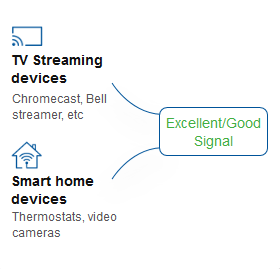

Is your device’s speed showing the expected quality?
FACTOR 1 – DEVICE AGE AND QUALITY Try these tips to improve your device’s Wi-Fi speed
- If possible, connect your console directly to your modem with a Cat5e or higher Ethernet cable. A wired connection is best for online gaming and helps reduce lag and latency.
- Close inactive games or apps on your gaming console. Apps can run in the background, consuming bandwidth and affecting speed.
- Ensure the gaming console has the latest manufacturer software update.
- Home Hub 2000 and 3000 users: Depending on the distance between your computer and your modem, consider purchasing Bell Wi-Fi pods or another mesh network product to extend the range of your Wi-Fi network coverage.
Did Wi-Fi speeds to your device improve after following these tips?
FACTOR 1 – DEVICE AGE AND QUALITY Try these tips to improve your device’s Wi-Fi speed
- Power your device off completely and power back on after 30 seconds.
- Confirm that your video streaming device has the latest software update provided by the manufacturer.
- Close inactive games or apps on your video streaming device. Apps can run in the background, consuming bandwidth and affecting speed.
- Home Hub 2000 and 3000 users: Depending on the distance between your device and your modem, consider purchasing Bell Wi-Fi pods or another mesh network product to extend the range of your Wi-Fi network coverage.
- If possible, try moving the device closer to your modem or connect your smart home device directly to your modem with a Cat5e or higher Ethernet cable. A wired connection helps reduce lag and latency.
- If you are having connectivity issues with a smart home device, try resetting it to factory defaults and setting it up again from scratch. Refer to the device’s app or website for details.
- Home Hub 2000 and 3000 users: Depending on the distance between your device and your modem, consider purchasing Bell Wi-Fi pods or another mesh network product to extend the range of your Wi-Fi network coverage.
Did Wi-Fi speeds to your device improve after following these tips?
Troubleshooting checkpoint
Now that you understand the effect of device age and quality on speeds to your device, there may be other things you can do to make the most of your Wi-Fi speed. Continue to explore the other factors that affect device speeds.
- Device age & qualitypassed
- Number of devices
- Location of the modem
- Signal interference
- Other frequencies
Would you like to continue learning about ways to improve Wi-Fi speeds?
FACTOR 2 - NUMBER OF DEVICES Your Wi-Fi network is shared among all devices in your home
The more devices connected to your Wi-Fi network, the bigger the demand on the network and the greater effect this has on speeds to your devices.
Higher-speed Internet packages deliver better Wi-Fi to many devices.
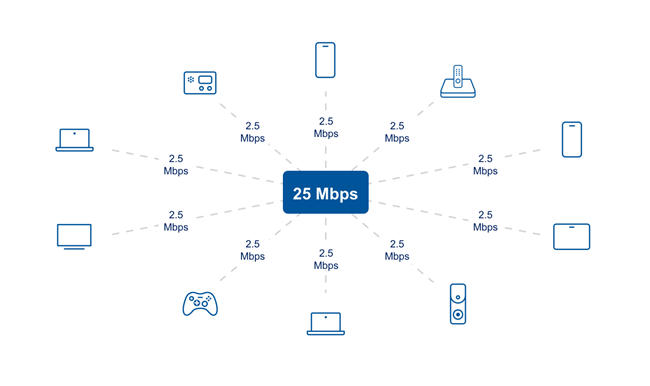
FACTOR 2 - NUMBER OF DEVICES Tips for connected devices
-
Devices may still use your Wi-Fi even when you’re not using them.
- Disconnect from Wi-Fi or turn devices off when you’re not using them.
- Use the Bell Wi-Fi app to set schedules for Wi-Fi access.
-
Certain activities use a lot of bandwidth, such as streaming videos in 4K.
- Reduce your viewing quality to HD
-
You may have more devices connected to your Wi-Fi network than your Internet package can support.
- See if a higher-speed Internet package is available.
Did Wi-Fi speeds to your device improve after following these tips?
Troubleshooting checkpoint
Now that you understand the effect other devices connected to your home network have on speeds to your device, there may be other things you can do to make the most of your Wi-Fi speed.
- Device age & qualitypassed
- Number of devicespassed
- Location of the modem
- Signal interference
- Other frequencies
Would you like to continue learning about ways to improve Wi-Fi speeds?
FACTOR 3 – LOCATION OF THE MODEM How the distance from your modem affects signal strength
Wi-Fi signal strength is strongest close to the modem, as shown in the image below. As Wi-Fi radio waves travel from the modem, they are affected by:
- Distance from the modem
- Obstructions such as walls, furniture, etc.
- Signal interference from other electronics (small appliances, microwaves, etc.)
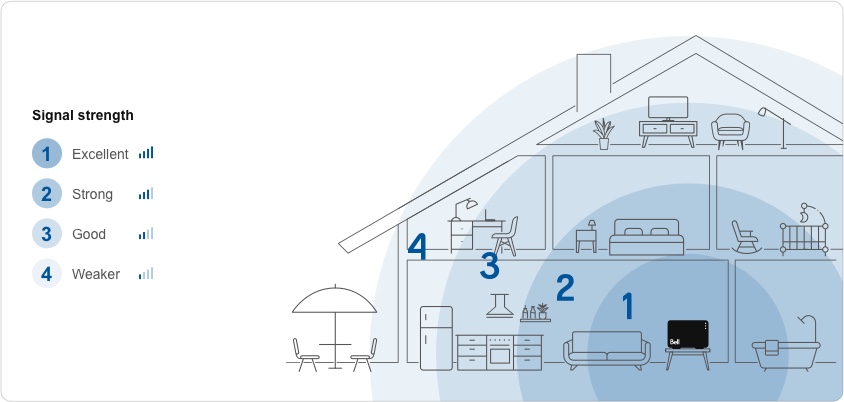
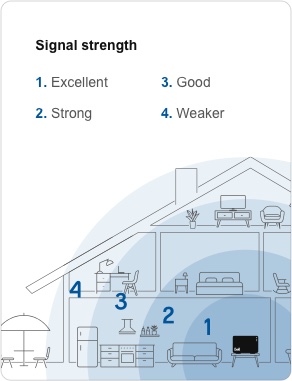
FACTOR 3 – LOCATION OF THE MODEM Test how well your Wi-Fi signal reaches throughout your home
Test the reach of your Wi-Fi signal by running multiple speed tests as you move away from your modem. Use the device that is experiencing slow speeds, if possible.
Choose one of the following options:
- Open the Bell Wi-Fi app and select Devices in the bottom right corner.
- Touch the devices tab.
- Select the device that is experiencing slow speeds.
- Note the Wi-Fi signal strength displayed below the device name.
- Walk away from the modem and refresh the app to see if the signal weakens as you get farther away.
Use a laptop or other portable device
- Run a speed test standing next to the modem and note the results.
- Move to the location where your device is experiencing slow speeds and run another speed test.
- Compare the speed test results.
TIP: Try to ensure that no other devices are consuming high bandwidth while testing (example streaming videos or online gaming).
*Eligible modems for the Bell Wi-Fi app
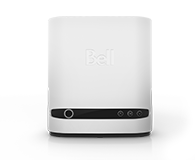
Home Hub 4000
/ Giga Hub
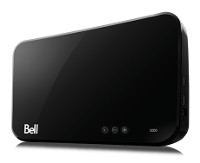
Home Hub 3000
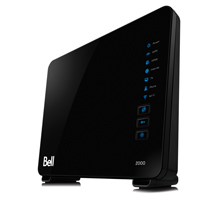
Home Hub 2000
How does your speed/signal strength change as you move away from the modem?
FACTOR 3 – LOCATION OF THE MODEM Try these tips to improve your signal reach
- Remove obstructions around your modem (cabinets, boxes, etc.).
- We recommend adding a signal boosting device/Wi-Fi mesh system to extend the range of the Wi-Fi signal in your home. Learn more
Did Wi-Fi speeds to your device improve after following these tips?
Troubleshooting checkpoint
Now that you’ve tested and confirmed your Wi-Fi signal reach, there may be other things you can do to make the most of your Wi-Fi speed. Continue to explore the other factors that affect Wi-Fi speed to your devices.
- Device age & qualitypassed
- Number of devicespassed
- Location of the modempassed
- Signal interference
- Other frequencies
Would you like to continue learning about ways to improve Wi-Fi speeds?
FACTOR 4 – SIGNAL INTERFERENCE How signal interference affects Wi-Fi speeds
All Wi-Fi signals compete with each other. There are certain sources of interference that may be contributing to slow Wi-Fi speed to your device.
-
High density living areas
Impacts are worse in apartments and condos with several neighbours in all directions.
-
Peak activity hours
Interference from neighbouring devices is worse when more people are using the Internet.
-
Older devices
Older devices have a harder time dealing with Wi-Fi interference.
-
Other electronics
Other electronics in your home can also interfere with your Wi-Fi signal.
FACTOR 4 – SIGNAL INTERFERENCE Try these tips to improve your device’s Wi-Fi speed
- Test your Wi-Fi speed at peak hours and non-peak hours and compare the results. Slow speed during peak hours will confirm signal congestion is reducing speeds to your device. Consider using a wired connection during peak hours to improve your speed.
- Move other electronic devices away from your modem.
- Try to use your device where it has a clear line of sight to your modem.
Did Wi-Fi speeds to your device improve after following these tips?
FACTOR 5 – OTHER FREQUENCIES Choose your modem to learn how to connect to the best frequency and channel available.
FACTOR 5 – OTHER FREQUENCIES How to connect your device to the appropriate Wi-Fi frequency
Your modem offers two different frequencies for your Wi-Fi signal: 5 GHz and 2.4 GHz.
The frequency your device should use depends on where you are using it in your home:
- Closer to the modem: 5 GHz is faster
- Farther from the modem: 2.4 GHz reaches farther throughout your home and deals with obstacles better
Bell modems will try to select the appropriate frequency; however, devices ultimately decide the frequency to which they connect.
Sometimes devices connect to a frequency that is not suited for where they are being used in your home, or to one that is already crowded by other devices, resulting in slower speeds.
-
Turning the device’s Wi-Fi off and on may help steer the device toward the most appropriate frequency.
-
Stand close to your modem when toggling the Wi-Fi to ensure that your device selects the best Wi-Fi channel and frequency available.
-
Any devices connected to the modem that are not used regularly should be powered off completely or have their Wi-Fi turned off to help minimize signal congestion.


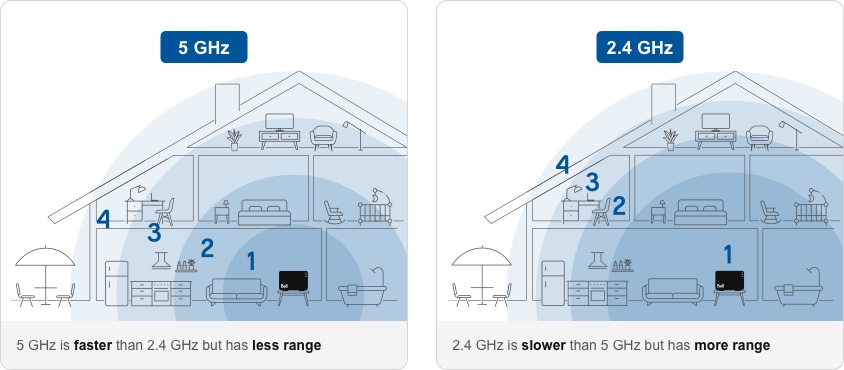
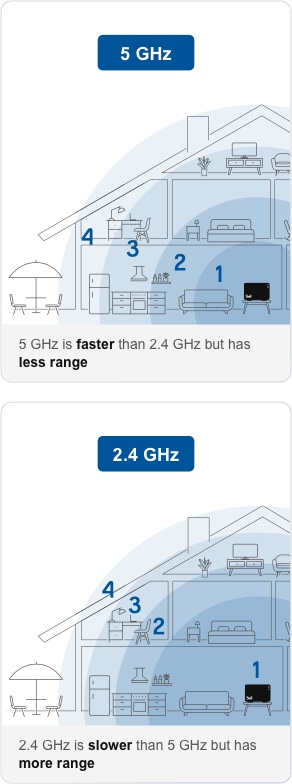
Did Wi-Fi speeds to your device improve after following these tips?
FACTOR 5 – OTHER FREQUENCIES How to connect your device to the best Wi-Fi channel available
Your modem offers a number of channels, and devices choose one automatically when connecting to your Wi-Fi network.
Bell modems will try to select the best channel; however, devices ultimately decide the channel to which they connect.
If your device connects to a channel that is already crowded by other devices, the Wi-Fi speeds to your device will be slower than expected.
-
Turning the device’s Wi-Fi off and on may help steer the device toward the most appropriate frequency.
-
Any devices connected to the modem that are not used regularly should be powered off completely or have their Wi-Fi turned off to help minimize signal congestion.
Stand close to your modem when toggling the Wi-Fi to ensure that your device selects the best Wi-Fi channel and frequency available.
Did Wi-Fi speeds to your device improve after following these tips?
Troubleshooting checkpoint
Now that you’ve reduced Wi-Fi signal interference, there may be other things you can do to make the most of your Wi-Fi speed. Continue to explore the other factors that affect Wi-Fi speed to your devices.
- Device age & qualitypassed
- Number of devicespassed
- Location of the modempassed
- Signal interferencepassed
- Other frequencies
Would you like to continue learning about ways to improve Wi-Fi speeds?
Finished troubleshooting
We hope these troubleshooting steps helped resolve your issue.
Factors that affect Wi-Fi speeds
-
Device age and quality
- Newer devices are able to handle greater speeds over Wi-Fi than older devices.
-
Number of devices
- Your Internet package should offer enough speed for all the connected devices in your home.
-
Location of the modem
- Wi-Fi signal strength is strongest close to the modem.
-
Signal interference
- A clear line of sight to the modem will improve speeds to your device.
-
Other frequencies
- Turning the device’s Wi-Fi off and on may help to steer the device toward the correct frequency and channel.
Did following these troubleshooting tips help improve Wi-Fi speed to your device?
If you need more help
Our technical experts are available to continue troubleshooting your Wi-Fi.
Ways to contact us:
Online: Chat live
Finished troubleshooting
Thank you for following our Wi-Fi troubleshooting.
